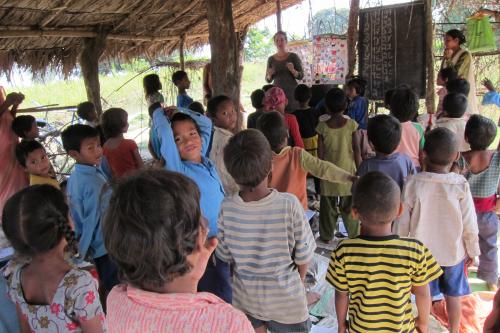
Recent fieldwork in the Hills and Terai region has highlighted the complexity of issues facing communities and the education system in Nepal. Here, I focus on one of these challenges, migration, and look at how volunteering operates in a complex terrain, and how it can be responsive to a society which is in constant flux, and grappling with the varied needs of an extremely diverse population.
In the Western Hills of Nepal, in one of the districts with the highest levels of outward migration (primarily to the Gulf states), international VSO volunteers are working with nine Government schools on a project that promotes quality and inclusive education for out-of-reach children. Volunteers are working with teachers to create a child-centred, inclusive learning environment in both rural and urban schools – both of which are affected by the increase in outward migration that has escalated in the last ten years.
After climbing uphill for almost two hours we arrived at one of the VSO focus schools. There were only a handful of children in most classes. The Head Teacher explained that the number of children was falling sharply – from almost 130 to less than 40 in the past few years. With men migrating to the Gulf states or to Malaysia, their families use the remittances to move temporarily to rented accommodation in the district centre. If means allow, children are sent to fee-paying English medium schools – a growing fashion in a country that holds English speaking in high regard. The falling rolls are problematic for this school: government funding based on the number of pupils has fallen, resulting in one teacher’s salary being divided between three teachers; teachers also spoke of how de-motivating it is for them to teach in this environment, with pupil numbers continually declining. ‘A forty minute lesson seems like a long time with so few children,’ one teacher confessed. Meanwhile in the district centre, some government schools are struggling with swollen class sizes due to inward migration, but also, regularity has become a major issue, with children returning to the villages with their families during festival and harvest times, living intermittently between town and village.
A 600km drive south west, in the hot, flat plains of the Far Western Terai, a different group of volunteers have been working on the same project. Visiting schools in predominantly Rana Tharu areas (an ethnic group indigenous to this region), provides a different picture of migration. People spoken with usually had a relative working overseas but more of an issue is the fluid movement of families between the open Nepali and Indian border due to links with other Rana Tharu families across the border. Cross-border marriages are commonplace for example and these familial links are stronger in some ways than their connections to Nepal, with many unable to speak fluently in Nepali and choosing to live separately from other ethnic groups and castes. In some villages, children will travel between their families’ villages in India and Nepal as their parents move for work and to harvest in the different areas. One local volunteer said that by the age of ten, half of the children in the village will cross the border to work in India for at least part of the year. Although baseline and follow-up surveys to capture the proportion of children not attending school have been undertaken in this area by an NGO working with VSO, the semi-nomadic nature of these children meant they could not easily be picked up on.
These complex migratory patterns create immense challenges for the Education system in Nepal, and also for communities more widely. For example, in the Hill district where VSO volunteers work, according to a local NGO, there is a 13,000 metric tonne food shortage because of the migration of young labour. Many migrate because of a lack of livelihood opportunities at home and the hope for increased earning power abroad. But, as a local community leader explained, it has also become a fashion, stemming from an inflated idea of what is available overseas and a widely held negative view of their own country’s development.
So can international volunteering be responsive to these trends? The presence of international volunteers undoubtedly attracts some parents and students to the school, both because of the expectation that they will bring expertise that will lead to quality learning (particularly of the English language), and a sense of interest and excitement. Volunteers are new and different, and can give schools credibility as well as sharing new skills and methods. But interestingly, when talking with teachers and parents, what is often commented on is the sense of responsibility to the community and an awareness of existing resources and natural assets, that the volunteer’s presence brought. This is significant in this context, where opportunities for both personal and community development (through remittances) are often sought abroad, rather than at home. I’ve often heard people say, ‘if this person wants to come from overseas to help us, why shouldn’t we help ourselves?’ This can be an important catalyst and lead to greater investment by people in their own communities and a different view of their own potential to lead change: ‘It shows that one person can make a difference…that we shouldn’t just blame the politicians’ (Teacher).
It can also serve to challenge romanticised views of developed countries. Last week one teacher told me that every day he thinks about a model lesson that a VSO volunteer gave during a training session. Previously, the volunteer had been known as ‘America Miss’ in the community despite being from a former Communist country in Central Europe. The lesson highlighted the similarities in the history between Nepal and the volunteer’s country, including the relatively late achievement of democracy and the level of poverty experienced in the last fifty years. The teacher drew parallels with his own community and the volunteer’s and said it made him aware of his own agency in the community’s development and the importance of taking responsibility. Debunking myths about the affluent and problem-free developed countries is often an unrecognised part of the volunteer’s role. But these socio-cultural exchanges, offer fuller and more realistic narratives about developed countries, which may lead to a change in perspective about what development means, and a re-appraisal of communities’ resources and natural assets.
Interestingly, local NGOs in the Hill district are building programs that are responsive to these migratory trends. When migrants return to the district, most are only able to save between $1000-2000 over two or three years, which is insufficient to maintain their family’s life in the district centre. Returning to the village can be a frustrating experience, but local groups have found that returned migrants are eager to volunteer in community development projects. They have broader experience, new skills and knowledge, and this can be used to, for example, set up model farms and give advice on farming techniques to other villagers - their elevated social standing making it more likely that fellow villagers are receptive to their advice. As well as sharing technical skills, the volunteers share experiences with young men who have not yet migrated, providing a realistic picture of life overseas. These young men are also given access to micro-finance schemes so that they can invest in small-scale farming in their own community.
The challenges for volunteers working in this context are immense. Top of the list is the difficulty to motivate teachers in schools where student numbers are falling, and teacher pay has decreased. Furthermore, the force of these wider systemic trends interrupts or undermines the intervention from the volunteers, making continuity and progression problematic, the work frustrating and achievements sometimes feeling thin on the ground.
Giving volunteers the space to both find out, and reflect on how these forces affect volunteer placements is sometimes sorely missing, and can lead to volunteers feeling negatively about their own or their counterparts progress. Also, could there be more recognition and understanding of how a volunteers’ (an outsider’s) presence and interactions can challenge typical narratives of globalisation and development, making this a more intentional part of what an international volunteer does?
Back in the Far West of Nepal, the migratory patterns of the Rana Tharu are inherent in their culture – this is not something to change, but rather for volunteer organisations to ask how they can be responsive to their needs. In one community, a local volunteer working with VSO found 70 children who were not in school and established a class where children are taught for three hours per day. The school that VSO have been working with in this area has made real improvements to the school and classroom environment, and has produced a thoroughly researched school improvement plan which they are working towards. But when thinking of the children most affected by these complex migratory patterns, should wider questions be asked about whether ‘Education for All’ means a school based education for all? And how can the unique culture of ethnic-groups like the Rana Tharu be preserved whilst ensuring that children have access to education? Perhaps volunteer organisations like VSO are uniquely placed to work with local volunteers and communities, and government agencies, sometimes across borders, to talk about these stories and think what Education should look like for the very hardest to reach.








7d88.png?itok=KI18yp23)

Comments
Great article
Really terrific article Lizzie, enjoyed reading, all very good questions
Add new comment